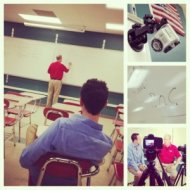My high school physics teacher taught me something really valuable, not just about physics, but something that can be applied to video production and life in general. Mr. Hodges would begin a physics problem on one side of the chalkboard.
There would be numbers, letters, and symbols flying around in every direction; in short time it would begin looking like the love child of the Greek alphabet and the value of Pi. After he had solved the problem, and filled the board from one end to the other, he still had three more letter to write…
P.O.C.
Piece of cake. That’s what it stood for. Why? Why torture us with P.O.C.? Because Mr. Hodges was smart. He knew about problem solving and what it takes to overcome a challenge. He was training us to recognize that if you approach a problem or challenge knowing that you’ll get through it because you have a plan and take it step by step – it really isn’t as hard as it looks.
In my profession I encounter a lot of people who see video production as a chalkboard full of physics equations – complicated, time-consuming, maybe even impossible.
I hope you’ll take a few minutes to enjoy this interview with my real high school physics teacher. Then I’ll share with you six lessons from our conversation that apply directly to producing video.
Here are six lessons I learned from Mr. Hodges that you can apply to video production right now…
Keep a positive attitude
Beginning any challenge uncertain of whether or not you’ll see it through to the end is a good way to make the challenge a lot harder. Hodges taught us that having a P.O.C. attitude set us up for success, even if the problem was huge. Start planning and producing your videos with a positive attitude. “This really isn’t that hard,” is going to get you a lot farther than “insert favorite excuse or complaint here.”
Start with what you know
When solving a physics problem in Hodges’ class, you wrote a list of what you knew and what you needed to find before you tried solving anything: the “given” information. Maybe the mass of an object and the force of friction on that object were all you had, but it was a start. When producing a video you should do the same. Start with what you know by identifying the basics of the video. It’s easy to get distracted by shiny objects like cameras, microphones, and lights, but when you’re first approaching the challenge of a video production I recommend you start with its purpose. Finding purpose for your video is a great way to start with what you know.
Break it down into steps
After sorting out what we knew and what we needed to find, it was time to start tackling the problem. But, there was always an easy way and a hard way to get to the end and lots of time and pencil erasers wasted away when the right steps weren’t followed. Similarly, many of us have been in the position of having recorded so much video content that we don’t even know where to begin when it comes time to edit it down and produce a simple, clear message.  Physics Video ShootBreak down your video step by step using a simple video planning template. Plan your interview questions, your B-Roll shots, and any other assets you’ll need. Do this planning before you even start the production and you’ll end up saving a lot of time.
Physics Video ShootBreak down your video step by step using a simple video planning template. Plan your interview questions, your B-Roll shots, and any other assets you’ll need. Do this planning before you even start the production and you’ll end up saving a lot of time.
Be patient
Duh, right? Maybe not. The thing about patience is that we’re most often focused on having patience with other people, but when it comes to solving big physics problems or producing videos, our patience is often tried most internally. We criticize ourselves when we see how we look on camera or we stop an interview because we said “umm” too many times. Maybe you’ve missed capturing the best soundbite because you made the mistake of asking your best questions before the camera started rolling. Be patient and keep your cool because you’ll…
Learn from your mistakes
Regardless of the mistakes or setbacks we face, our patience can help us learn and improve if we allow it. With physics, you can make a simple math error and you’re going to get the wrong results. With video production, it can be the same. The good news is with video becoming more and more forgiving, you can afford to make a few mistakes here and there and learn from them. Just don’t be the student that walks out of the classroom and drops physics to pick up a study hall period. Learn from your mistakes and get better.
Know where to go for answers
Your mistakes can teach you a lot, but they might not teach you everything. “An educated person is someone who knows where to go when they need information,” says Hodges. Need video ideas? Check out Candidio’s “A Video You Can Do” series or discover some that may be right under your nose. Need suggestions for video equipment or editing software? Search the countless reviews on the web or ask a video production company for advice. Of course, the team at 12 Stars Media is here as a resource for you and from Candidio to strategic video planning to video production services we can help solve a lot of problems. Just don’t ask us for help on your physics homework.
Have you enjoyed or learned something from Mr. Hodges or from his pupil (that’s me)? Leave a note in the comments and maybe he’ll read it out loud to the class.




